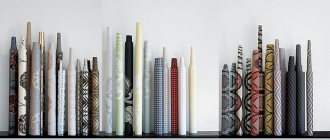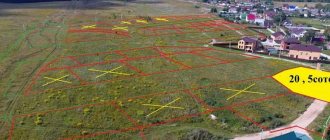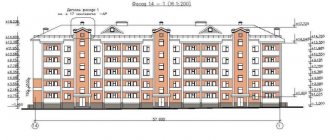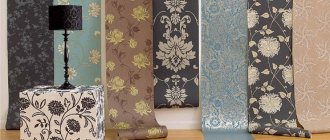0
14.10.2021
Most people prefer to do the renovations themselves, especially when it comes to cosmetic updates in their own apartment. Thus, you can significantly save money, since you do not have to pay money to hired craftsmen. But often at the preparation stage they are faced with problems regarding how much material to purchase and how many meters in a roll of wallpaper. It is important to know this so as not to overpay for surpluses or face shortages in the process.
In order not to make a mistake with the amount of material required, you must be able to make calculations
Common wallpaper sizes
The large size range of wall coverings is explained by the variety of materials, textures, types, manufacturers, as well as countries of origin. An approximate list of standard values for common types is as follows:
- paper wallpaper, as a rule, has a width of 53 centimeters and a length of 10 m (sometimes 8 and 12 m);
- vinyl sheets – 50 cm wide and 15 m long;
- non-woven material - width 106 cm, footage - 10 or 12 m;
- textile coverings can have a width ranging from 53 to 80 cm and a length of 10 m;
- fiberglass parameters - 53 cm width by 10 m length.
Interesting! In high demand, meter-long wallpaper for painting is found in rolls of 25 or even 50 m, and super-dense non-woven wallpaper, used as accent elements, is available in rolls of 5 m.
Note! The standard width of the canvas from British, Italian and some German manufacturers is 74 cm, so it’s worth double-checking the markings.
How wide are non-woven wallpapers?
width
roll: the vast majority of samples have an indicator of 530 (mm) or 1060 (mm), some European manufacturers adhere to
a width of
700-750 (mm); roll length: most manufacturers adhere to 10050 (mm), some samples have lengths of 12000 (mm), 15000 (mm) and 25000 (mm).
Interesting materials:
How to change the password on Wifi byfly? How to change the password on zyxel? How to change your iCloud password? How to change your Instagram password? How to change root password in MySQL? How to change the password in Gmail? How to change password in gmail email? How to change your password in Fortnite? How to change password in gmail com? How to change the password in gmail mail?
Wallpaper roll size chart.
| Length (m) | Width(cm) | Wallpaper base: |
| 10 | 53 | paper or nonwoven |
| 10 | 70 | mostly paper |
| 10 | 90 | rare format |
| 10 | 106 | usually - non-woven |
| 25 | 106 | usually - non-woven |
| 50 | 106 | usually - non-woven |
Standard parameters
Pasting wallpaper with your own hands, pasting walls with different wallpapers, examples and methods of pasting
Wallpaper is packaged in rolls resembling thick-walled tubes. The standard parameters are the most popular dimensions for 1 roll. Such wallpaper is available in every hardware store.
Length
The usual and most popular is a ten-meter roll. Most manufacturers make rolls this length. But there are other options. For example, a length of 15 linear meters is used for narrow (50 cm) vinyl wallpaper. A length of 25 linear meters is used for meter-long non-woven wallpaper.
Such long rolls are used for covering large rooms and halls.
Width
Based on the width of the wallpaper, there are three most common sizes:
- 50 cm;
- 70 cm;
- 106 cm.
Often the width varies depending on the country of origin. For example, a width of 70 cm came to Russia from European countries (Germany, France and Holland). Since foreign building materials are considered to be of high quality, wallpaper from these three countries began to quickly gain popularity. Such wallpapers are often used for horizontal gluing and creating a unique interior. Their price is much higher than domestic ones, but this does not bother many.
In Russia, the standard sizes are 1 m and 0.5 m. The width of 50 cm is the most popular. The convenience of this width is that a person alone can cover the entire room, since the roll is often very light. They are also easy to smooth out.
A wide wallpaper format is gaining popularity - 106 cm. Such wallpapers are often more expensive than narrow counterparts, but their main advantage is that the decorative layer is applied not to paper, but to a non-woven base. This base gives the canvas rigidity and adheres without bubbles.
Weight
When calculating the weight of the material, it is important to know that wallpaper comes in several types of density:
- The lungs have a density of 40 grams per square meter. A standard narrow roll will weigh about 500g;
- Non-woven wallpaper can support its weight and has a density twice as high as its lightweight counterparts - a roll weighs a kilogram;
- Multilayer vinyl wallpaper has such a density that it is very difficult to tear it - 130 grams per square meter. The roll weight exceeds 1.5 kg.
Table for calculating wallpaper around the perimeter of the room
(standard - 10.05x 0.52=5.2 m2)
| Ceiling height | Distance around the room (perimeter), including windows and doors, in m | ||||||||||
| 9 | 10 | 12 | 13 | 14 | 15 | 16 | 17 | 18 | 19 | 21 | |
| 2.15-2.30 | 4 | 5 | 5 | 6 | 6 | 7 | 7 | 8 | 8 | 9 | 9 |
| 2.30-2.45 | 5 | 5 | 6 | 6 | 7 | 7 | 8 | 8 | 9 | 9 | 10 |
| 2.45-2.60 | 5 | 5 | 6 | 7 | 7 | 8 | 9 | 9 | 10 | 10 | 11 |
| 2.60-2.75 | 5 | 5 | 6 | 7 | 7 | 8 | 9 | 9 | 10 | 10 | 11 |
| 2.75-2.90 | 6 | 6 | 7 | 7 | 8 | 9 | 9 | 10 | 10 | 11 | 12 |
| 2.90-3.05 | 6 | 6 | 7 | 8 | 8 | 9 | 10 | 10 | 11 | 12 | 12 |
| 3.05-3.20 | 6 | 7 | 8 | 8 | 9 | 10 | 10 | 11 | 12 | 13 | 13 |
Material characteristics
Meter wallpapers are becoming more and more popular every day - people want something new and “fresh”, and unusual and colorful wallpapers are just that. The width of the material is almost 2 times greater than the usual 53 cm. They come in 90, 110 and even 140 cm wide, and if you know how to properly glue meter-long wallpaper, you can only imagine how quickly such repairs will take place!
Of course, you have to pay a hefty sum for all the attractive new items, and wide wallpapers often scare ordinary people with their price tags. But those who have already dealt with this material unanimously claim that every penny spent is worth it - the wallpaper looks uniform, harmonious, lasts a long time and is unpretentious to use.
It's time to consider the advantages of meter wallpaper:
- Gluing meter-long wallpaper is much faster and easier (using the equipment) than standard wallpaper.
- The drawing turns out to be more complete.
- Fewer joints and seams.
- Wide wallpapers are produced only abroad using special technologies and high quality.
- Despite the seemingly high cost of meter-long wallpaper, one roll will be cheaper than two rolls of regular wallpaper of the same quality.
- Ideal for large rooms.
As usual, even the highest quality products have their drawbacks, and meter-long wallpaper is no exception:
- Gluing them alone is quite problematic, especially if you are doing it for the first time.
- Before pasting, you need to prepare the walls very carefully - wide wallpaper looks good only on perfectly smooth and even surfaces. Otherwise, the joints of adjacent wallpaper strips will be distorted.
- Despite the impressive width, the length of the wallpaper may not be enough, which is why you will have to buy an additional roll, so you need to take accurate measurements of the area of the room before going to the store, especially for rooms with non-standard square footage.
Method No. 1
The calculation based on the area value is as follows:
- The height and length of each wall intended for pasting is measured, and the area of the entire surface is calculated.
- If necessary, the area of window and door openings is subtracted from this value. The resulting value in m2 is the required amount of coverage.
If there is only a small window and a single-leaf door in the room, then their sizes are usually not taken into account in the calculations, leaving the expected surplus “as a reserve”. In the case of a non-standard layout (panoramic window, several or enlarged doorways), the difference can reach up to a whole roll, which means it makes sense to calculate the working surface area as accurately as possible.
- Now we determine how many square meters are in each roll of wallpaper. To do this, the length of the tube is multiplied by its width.
- It remains to calculate the number of tubes themselves. The working surface area is divided by the square footage of material in one roll and rounded up to a larger whole value.
Example:
The width of the wallpaper is 50 cm (0.50 m), the footage is 15 m.
Room height – 2.7 m, parameters – 4 × 2.8 m, window and door of standard sizes.
- 4 × 2.7 = 10.8 (m2) – area of one wall.
- 2.8 × 2.7 = 7.56 (m2) – area of the other wall.
- 10.8 × 2 + 7.56 × 2 = 21.6 + 15.12 = 36.72 (m2) – total surface area for pasting.
- 0.50 × 15 = 7.5 (m2) – coatings in one roll.
- 36.72: 7.5 = 4.8 (round to 5)
Paper wallpaper
If you are looking for suitable types of wallpaper for the bedroom, then you should pay attention to traditional paper ones. Such wall coverings have the longest history among all other types; it goes back centuries.
Their homeland is East Asia, from where they came to Europe in the 18th century. Since then, wallpaper has been widely used, and today it is difficult to find at least one house in which finishing materials of this or a related type are not used
Such wall coverings have the longest history among all other types; it goes back centuries. Their homeland is East Asia, from where they came to Europe in the 18th century. Since then, wallpaper has been widely used, and today it is difficult to find at least one home that does not use finishing materials of this or a related type.
Paper wallpapers are relatively inexpensive, they are easy to glue, and they are water-repellent. They can be painted in any color, thereby refreshing the look of the room.
Nowadays, there are different types of paper wallpaper.
Now they are produced not only smooth, but also with an imprint (structural).
There are also two main types: two-layer (duplex) and single-layer (simplex). The former have a protective coating that protects them from environmental influences. Single-layer wallpaper is not as wear-resistant, but is cheaper. Despite the difference in price, two-layer paper products are in great demand. In any case, such wall covering will please the eye for about 5 years.
How to find out how many square meters
Regardless of which options you use standard or meter wallpaper, you need to know how many meters there are in a roll. To do this, you need to perform some calculations; they will help determine the required volume for the walls of the room.
Since the sheet has a rectangular shape, the area of the surface to be covered is calculated by multiplying the length and width:
- If the dimensions are 10.05 m by 0.53 m, then the formula is 10.05 * 0.53 = 5.3 m2 - this is an area indicator.
- With dimensions of 15 m and 0.53 m, it turns out - 15 * 0.53 = 7.95 m2 (area).
- 25 m and 1 m gives an indicator of 25 m2 of total area.
To determine the required quantity for one room, it is recommended to measure its walls using a tape measure. After this, the total area of the walls is calculated. It is advisable to take with a reserve; it is better to have some left over than to then go shopping in search of the missing material with the required pattern and color.
Indicators depending on the type
Each type of material has its own most common indicators, which must be taken into account in order to obtain preliminary calculations. A special feature of roll products is that the final calculation is made directly at the time of purchase. This is due to the fact that the hardware store does not always have in stock the desired products of the required length.
One roll of wallpaper, depending on the type, has the following dimensions:
- Paper products are produced in a width of 53 centimeters and a length of 10 m. Although sometimes there are options of 8 and 12 m.
- Vinyl products have the following parameters: 0.5 m width and 15 m length.
- Non-woven variations are produced in sizes 106 by 1000 (1200) cm.
- Textile materials are found with a width of 0.5 to 0.8 m and a length of 10 m.
Label of Alians paper wallpaper 53 cm wide and 10 m long.
But the values may differ if we are talking about roll products that are produced for wholesale buyers. This category includes firms and organizations engaged in large-scale repair and finishing work. It is for them that products with a width of 0.8, 1 and 1.5 meters are produced. At the same time, one roll of wallpaper contains from 10 to 25 meters.
On a note! Sometimes completely non-standard options come onto the market. They are considered defective and are sold practically at cost. Also, if necessary, some varieties can be made to order.
The width of the defective web may have different values at the beginning, middle and end of the roll, which causes significant difficulties during joining
How to determine the top of a wallpaper roll: count correctly
In this case, the top edge is located at the end of the roll, and the bottom edge is located inside. In this case, a person standing on a stool holds the upper edge of the wallpaper at the desired level with his hands, and unwinds and cuts off the lower edge. In general, for plain wallpaper or with a faint pattern, it doesn’t really matter how you glue it – “top” or “bottom”.
Sometimes the corresponding words are additionally printed on the top edge of the wallpaper.
Preparatory work
Before you start hanging wallpaper and transforming your home, you need to go through several mandatory steps - prepare the walls and carry out calculations. Without this preparation, any idea is doomed to failure, so read the sections below carefully.
How to calculate wallpaper consumption
Correctly calculating the amount of wallpaper for repair will help you save an impressive amount and get the job done accurately and quickly. Many people decide to use a special program for this purpose - an online wallpaper calculator. But even the best calculator will not help you with wide wallpaper, especially if you are lucky enough to own an apartment with a non-standard layout.
Carrying out calculations consists of several stages:
- You should start with the perimeter, calculating it according to an elementary scheme familiar from geometry lessons: (length of the wall + length of the adjacent wall) x2. For example, if there is a wall 4 m long and a wall 3 m long, then the calculation will look like this: (4+3)x2=14 m.
- Measure each wall separately along the bottom edge, making allowances for doorway recesses, recesses and protrusions.
- Many people “subtract” doors and windows, reasonably believing that wallpaper will not be spent on them. But if you are not good at calculations and cannot calculate how much window and door openings take up in total, it is better to have a little material left over than to have to buy another roll in case of an error.
- Is it necessary to glue wallpaper behind furniture? Ideally, yes. In general, before pasting it is advisable to remove all furniture from the room. But if we are talking about a bulky wardrobe covering an entire wall, which you are not going to rearrange for the next few years, then you don’t have to burden yourself with unnecessary worries and costs.
- It is always recommended to keep a roll or half a roll in reserve. This is necessary in case of unplanned repairs, replacing a piece of wallpaper (a child painted it with a felt-tip pen, a dog scratched it, etc.). If you do not leave anything in stock, then finding exactly the same wallpaper on the market can then be quite problematic.
Surface preparation
When working with wide wallpaper, the most difficult and time-consuming task is not pasting, but preparing the walls. You should start this even when the ceiling is being finished, if you are dealing with a new building or doing a major renovation in the apartment.
What is the preparation of walls:
- Remove the covers from all outlets and switches, and carefully cover the openings with electrical tape or masking tape so that it can be easily removed after work.
- Remove all fasteners (nails, screws, self-tapping screws) from the walls.
- Remove old covering (wallpaper, paint, etc.). It must be removed completely, down to the smallest pieces.
- If necessary, level the walls by filling potholes and cutting off bumps. The dried putty should be rubbed with fine sandpaper.
- It is mandatory to apply one or two primers even on perfectly smooth and even walls. It increases the adhesion force of wallpaper to the wall and significantly saves adhesive composition. The primer clogs all the smallest holes in the wall, preventing the glue from being absorbed into it and ensuring strong adhesion of the wallpaper. The glue must be applied to a completely dry primer. Drying times vary and depend on the number of layers applied. See the primer packaging for more details.
If you have an apartment with catastrophically crooked walls, the alignment of which will take a lot of effort, money and time, it makes sense to consider the option of covering the surface with plasterboard. In this case, you can “kill two birds with one stone” - create a perfectly flat surface and provide high-quality thermal insulation, which is especially important for modern apartments with thin walls.
A video on how to glue wallpaper and properly level walls will help you do the work quickly and competently:
Definition of markings on a roll
Before starting the process of selecting the necessary trellises, each person should familiarize themselves with the decoding of the symbols on the packages. This will allow you to find out the properties of the wallpaper you are purchasing and not become hostage to unpleasant consequences. A description of the symbols is presented in the image below.
Wallpaper is an integral part of the interior of a room, which is why many people approach the issue of choosing the right option for their home with such trepidation. Manufacturers are also not standing still and are expanding their sales range every year in order to attract the attention of more buyers. It is worth noting that distributors do not always meet customers halfway and share reliable information with them. You can also understand them: the more they sell, the more money they will earn. Therefore, you can only rely on your own knowledge. Using the information presented in this article, each buyer will be aware of the issue of choosing a suitable roll of wallpaper and will be able to calmly make the necessary calculations, calculating the cost of repairs.
Gluing meter-long wallpaper (video)
Modern wallpaper comes in a myriad of colors, shades, patterns and textures. They are durable, can be washed and painted repeatedly, and can decorate your room for many years without needing to be refinished. Polymer wallpaper is safe for humans and can be easily applied even by one person. As a rule, the width of a roll of wallpaper is 53 or 106 centimeters; for imported wallpaper it is 70-75 centimeters. The roll length is standard and is a little more than 10 meters, in rare cases 25 meters. It will not be difficult to calculate how much wallpaper and glue will be needed to cover a room. All wallpapers are marked with special icons indicating the conditions of their use and gluing. Wide "professional" wallpaper is used for covering large rooms, and is usually not as widely available as regular wallpaper.











